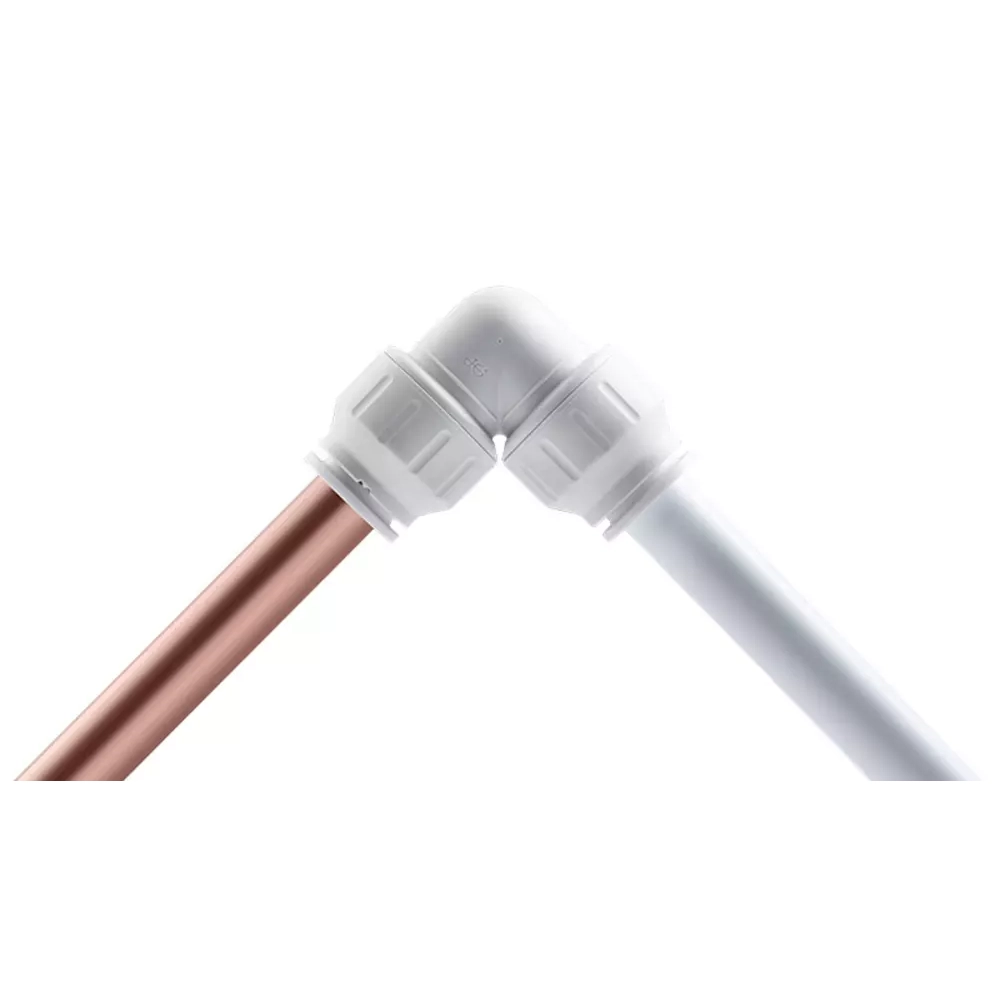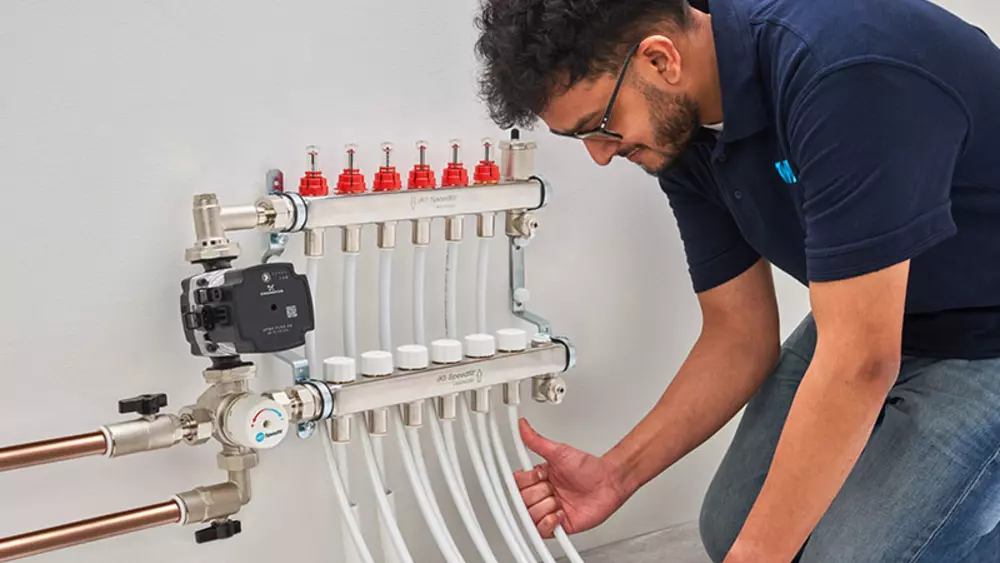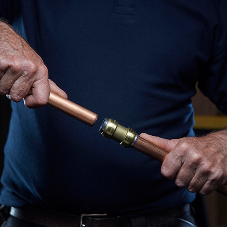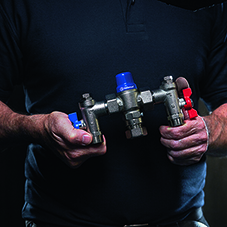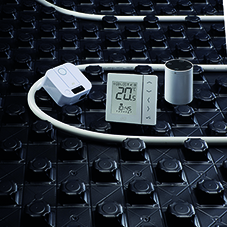The benefits of plastic push-fit fittings have established this technology as the go-to choice for installers, having been used in plumbing and heating systems for decades. The fittings are popular with consumers and tradespeople alike because they are remarkably straightforward and easy to use.
The push-fit concept is engineered to provide a tight and waterproof seal between fittings and pipe, creating a secure connection even when hidden in finished walls and ceilings. And seemingly simple at a first glance, RWC’s JG Speedfit plastic push-fit solutions have a few hidden facts sealed away. Here is Reliance Worldwide’s list of interesting facts about plastic push-fit fittings.
Fact 1: The Plastic Material Means the Fittings are Unaffected by Pitting Corrosion
Pitting corrosion is a form of corrosion where cavities or holes are formed in the material. The benefit of plastic push-fit fittings is that they remain unaffected by pitting corrosion and this is one of the main reasons they are so reliable.
Most commonly pitting corrosion in the UK hits those parts of the plumbing system that never exceed 40°C, where the water supplied is hard, lacks organic matter and has a pH value between 7.0 and 8.2.
In comparison, plastic plumbing circuits are resistant to such conditions and numerous tests have proven that these pipework systems are suitable for acidic environments. The combined use of plastic push-fit fittings and Polybutene-1 pipe brings flexibility to the installation process, offering system longevity and durability even with the variable microbiology of water supply.
Fact 2: The Fittings Are Entirely Tool Free
That’s right, plastic push-fit fittings are completely tool free. The pipe simply needs to be inserted within the fitting, where leak free connection is ensured with that same push-fit action, for which no tools are required. Because of this push-fit fittings are entirely demountable, meaning they can be disconnected and reused should a system need to be dismounted.
Of course, tools need to be used to cut pipes to size and ensure for clean connections between pipes and fittings, but to create the connection itself – no tools are required.
If you feel the lack of tools makes for a less secure connection, you should be safe in the knowledge that the fittings come with internal O-Ring seals that ensure a leak proof seal, while a collet with stainless steel teeth keeps the pipe securely in place.
With standard JG Speedfit fittings, the collet covers come in white, red, or blue, so that pipes can be colour coded. Additionally, a white or grey collet clip is used with a standard fitting to prevent accidental pipe disconnections whereas red or blue collet clips simply provide colour coding of pipe on Twist & Lock fittings. They are not designed to prevent accidental release and must be fitted when the Twist & Lock fittings are in the locked position.
Fact 3: The Fittings Are Compatible with Both Plastic and Copper Pipe
Push-fit fittings are available in various materials for different kinds of applications. Almost all pipe types have corresponding push-fit fittings designed for them.
You may think that because the fittings themselves are made of plastic, the pipes they connect to must be made of the same material. This is the case for some fittings – most copper connectors require copper pipe. However, RWC’s JG Speedfit fittings are far more versatile than this as they can securely connect plastic and copper pipework equally well. Additionally, JG Speedfit Pipe Inserts further help ensure installation rigidity when Speedfit plastic pipe is connected to a push-fit or compression fitting.
Fact 4: Push-Fit Fittings Can Be Connected, Whilst Residual Water Remains in The Pipework.
Another benefit of push-fit fittings, similarly to nut and olive type connectors, is that they do not require the pipe to be 100% dry when making the connection. This is unlike most solvent gluing or torch connecting methods and it is one of the reasons why push-fit fittings are much quicker to install. That is not to say that you should be careless when making the connection. It is important to keep the fittings and pipes clean by storing them in bags and boxes provided.
Make sure to keep the internal O-Ring seals free of dirt and debris by not emptying push-fit products onto the floor. Any damage to the O-Ring can compromise the watertight seal, so make sure there aren’t any burrs on the end of the pipe – these are usually caused by improper cutting techniques such as using a hack saw.
Fact 5: Push-Fit Fittings Have Uses Other Than Plumbing
Although currently push-fit fittings are commonly associated with plumbing and heating, the plastic push-fit concept has originally been designed by John Guest for compressed air applications in 1974. And ever since then many industries have benefited from this small but mighty solution. Here are some of them:
• Push-fit helps drive your car
Initially push-fit fittings were being used for fuel systems and now they are an essential part involved with low-pressure power steering systems and aiding the development of greener engines.
• Push-fit connects you to the internet
In the 1980s the first ever fibre optic push-fit fitting was developed by John Guest in collaboration with BT. Such fittings are now commonplace, with over 2.5 million being produced every year for delivering high speed internet to millions of homes and offices.
• Push-fit fittings help deliver purified water
The push-fit solutions can also be found in water purification systems. These food grade fittings have been designed specifically for fluid control and drinks dispensers meaning that when using water systems in offices and other public places, water is safe to drink, while systems are easy to maintain and repair.
• Push-fit fittings connect vital systems at your local garage
There are many appliances in a garage that make use of the push-fit technology: compressed air systems for filling tyres with air and solutions for changing them, as well as wheel balancing and driving pneumatic tools for servicing vehicles, to name a few.
Fact 6: The Plastic Push-Fit Fittings are Perfectly Suited to Plumbing Projects Outside of The Home too
Here are a few examples,
• Boats
The flexibility of the push-fit system ensures it can be cabled easily around the interior of a boat and hidden from view.
• Caravans
The benefits of push-fit fittings mean that they are ideal for caravan installations due to their flexibility and resistance to corrosion and freezing.
• Exhibitions
The unique ability of the push-fit system to be easily demounted and reused, together with its flexibility, makes ideal for use in exhibitions.
Fact 7: The Fittings Can Withstand Extreme Temperatures
The plastic push-fit fittings can intermittently withstand temperatures of 114 °C for short periods of time. Because the usual working temperature of central heating systems is 82 °C, with highs of 105°C, the plastic push-fit fittings are suitable for central heating systems.
In short, and among many other benefits, RWC’s JG Speedfit plastic push-fit fittings offer significant temperature and corrosion resistance, they are entirely tool free to connect and disconnect, are compatible with both plastic and copper pipe, as well as their reliability resting on years of cross-industry application, innovation and research.
The benefits of using JG Speedfit’s plastic push-fit fittings speak for themselves. And to find out more, you can have a browse here.
The Benefits of Push-Fit Fittings: 7 useful facts you need to know
| T | (01895) 425333 |
|---|---|
| E | Info@RWC.com |
| W | Visit RWC – Reliance Worldwide Corporation's website |
| Horton Road, West Drayton, Middlesex, UB7 8JL |


